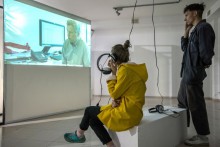The exhibit is part of the international festival “Art against Corruption.” The events are being held in nine cities of Ukraine and in Chisinau, Moldova, under the auspices of the Goethe-Institut in Ukraine.
“Corruption is an international problem,” Ilona DEMCHENKO, festival organizer, assistant at the special cultural programs department of the Goethe-Institut in Ukraine, emphasized. “It also exists in Germany. They fight it there by means of economic and political reforms as well as culture. In June, Berlin hosted the international symposium “Irresistible?” under the aegis of the Federal Center of Political Education. It was the first “module” of a project aimed at thoroughly exploring the phenomenon of corruption, including by art methods.
The “Gray Cube” exhibit displays the works of Ukrainian, German, and one Moldovan authors. One of the brightest (and difficult to perform) projects is the multimedia installation “Tower” by the well-known German visual artist, stage director, Berlin Arts University professor Hito Steyerl. The three-channel 3D video, which was created in collaboration with Oleksii Radynskyi (Kyiv) and Oleh Fonariov (Kharkiv) and uses video game scenes, is about the history of Ukraine from the beginning of independence until the Maidan and the ensuing events. Steyerl’s chief theme is the hybrid war (the artist draws a parallel with video games). The main question of “Tower” is duration of the military conflict. Steyerl is sure that war is corruption.

The rest of the “cube’s” projects (“Left Bank” and “Troieshchyna Two” by Oleksii Radinskyi; “We Need a Human” by Stanislav Menzelevskyi, Anna Onufriienko, and Oleksandr Teliuk; “The River Chorna” by Ghenadie Popescu; and “Lustration” by Dana Kosmina), frankly speaking, fuse into one – perhaps because all the authors presented videos. Good videos, but… What stands out against the general background is a cycle of Oleksandr Burlaka’s photos. The artist and architect says he photographed Mezhyhiria on February 22, 2014, in the first hours after Yanukovych’s flight, when people were only beginning to get into the ex-president’s residency. The luxury and, at the same time, awkward taste of the interiors, in which a very rich owner of the manor felt rather comfortable just a few hours before in a too impoverished country, cause the sensation of repugnance.
But Mr. Burlaka’s “photo wallpaper” (including the picture of a gilded toilet activists put up on the pedestal of the torn-down Lenin monument in Kyiv’s Besarabka on February 3, 2014) would not be having such a strong effect on the spectator if it were not for an amazingly successful curatorial concept of the exhibit and its “architectural” formulation by Dana Kosmina. For the exposition not to look like a placard-style agitprop, curator Kateryna Mishchenko made a nontrivial move: she suggested considering society as a “body” in the literal sense of the word. Accordingly, corruption transformed into the “problem of corporeality” – it is not just a “false” circulation of money in social nature. But any body has its own architectonics. This is why the exhibit has also turned on the whole into a purely architectural, and very integrative, project. Ironically playing on the concept of a “white cube” (since the 1920s, art has been exhibited in modern galleries against the background of white walls – the very architecture of the premises will not distract attention), Kosmina “built” the exposition in the shape of cubes. The video demonstrated in cube-shaped pavilions calls up an association with individual cells of a whole body. But since the cube is gray, not white, it is, in all probability, about cancerous cells. Corruption is a malignant tumor.
As for Burlaka’s photos (let us speak of them because, together with Steyerl’s video, it is undoubtedly the exhibit’s star project), Kosmina and curator Mishchenko played on the kitsch and haughtiness of Mezhyhiria specifically and very subtly. They suggest watching about a half of all the pictures through a “fence” of semi-transparent plastic. Spectators peer into what seems to be bullet holes to see what is over there, beyond the fence. “We want to raise the question of the effectiveness of ‘public opinion’ and discuss one thing: we have seen and named corruption, but what’s next?” Mishchenko explains. “And the green color of the wall hung with Burlaka’s photos resembles the green fences of our officials’ state-owned dachas. The same applies to a synthetic curtain – the ‘fence’ that separates the other part of the Mezhyhiria photos from audiences.”
We all know very well about Ukrainian corruption. The question is what we are to do with this knowledge.







